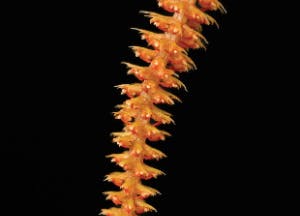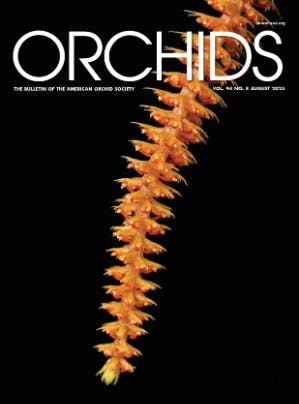
In the first part of this series (May), we discussed the general provisions that must be met to induce flowering. In general, there are two significant components to flowering, energy reserves and meeting the environmental factors to which individual orchids are adapted. Is my plant physically mature enough to bloom? Is it large enough to build up reproductive reserve energy? A good root system is absolutely critical to this. Once these needs are met, a collection of environmental factors, depending on the genus, comes into play. These include diurnal variation between day and night temperatures, absolute day and night temperatures, seasonal variation in day length, seasonal variation in light levels, and seasonal variations in water availability.
[1] Cattlianthe Jewel Box ‘Scheherazade’ CCM/AOS; grower: Elmore Orchids.

As a group, species in the Cattleya Alliance are strongly dependent on changes in day and night length throughout the year. Careful selection of parents can spread the flowering season out somewhat, but few cattleya hybrids will flower randomly throughout the year. Instead flowering, depending on their background, may be winter into spring (triggered by the days getting longer after the winter solstice), spring into summer (triggered by passing the spring equinox) and so forth — for instance, Cattlianthe Jewel Box typically flowers from January to late April or early May. The cross is a direct hybrid of the winter-flowering Guarianthe aurantiaca and a complex hybrid representing a collection of spring-flowering species. This dependence on day length was the backbone of the cattleya cut-flower industry of the 1940s and 1950s. As an example, Cattleya Trimos (mossiae × trianae) is so dependent on day length that its flowering can be timed in the same way that growers now force Poinsettias for the Christmas season.
[2] Cattleya trianae ‘Canthi’ AM/AOS; grower: Bruno Pareja Herrera.

[3] Cattleya mossiae f. reineckiana (Semialba) ‘Claire’ AM/AOS; grower: William Rogerson.

[4] Guarianthe aurantiaca ‘Walby’ AM/AOS; grower: Walter Hiraishi.

[5] Guarianthe bowringiana ‘Kathleen’ AM/ AOS; grower: William Rogerson.

If you have trouble flowering cattleyas, especially those with a sharply defined flowering season such as “fall purples” or “winter whites,” and you are sure they are mature enough to flower and are getting proper nutrition, check your variation in day length. This is especially important when bringing plants in as temperatures cool or moving them outdoors in the spring. — Ron McHatton (email rmchatton@aos.org)












